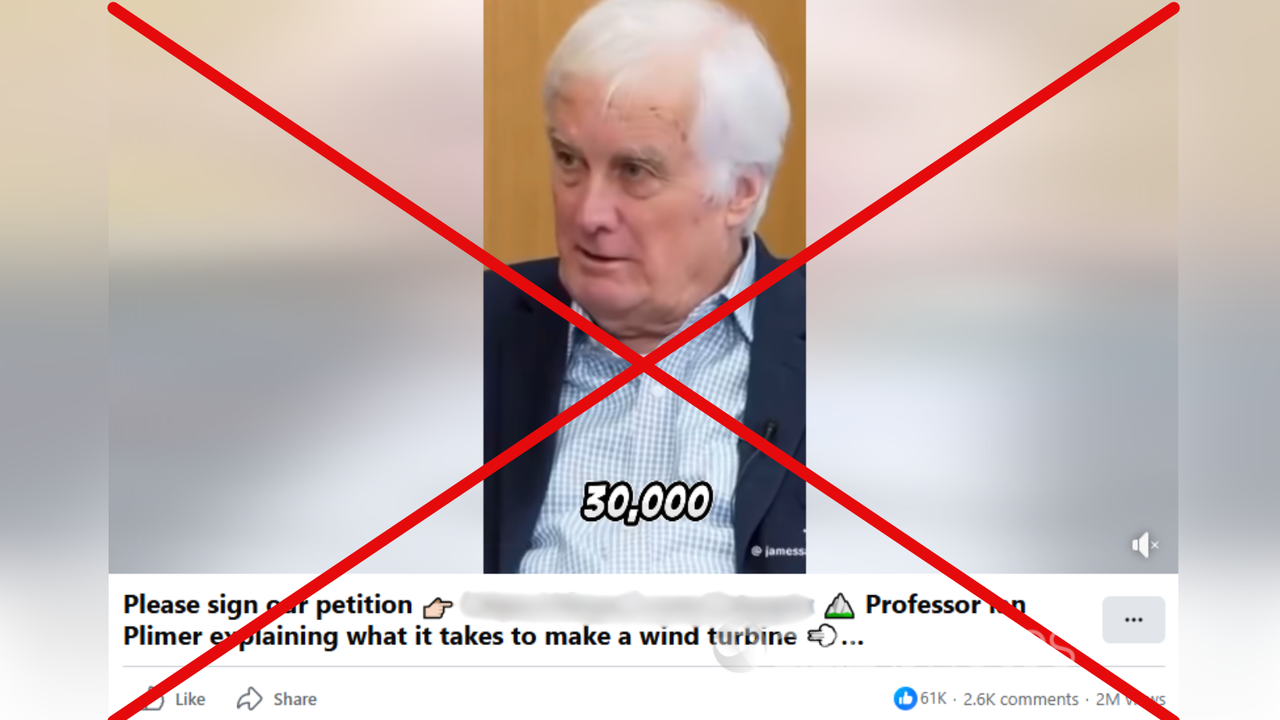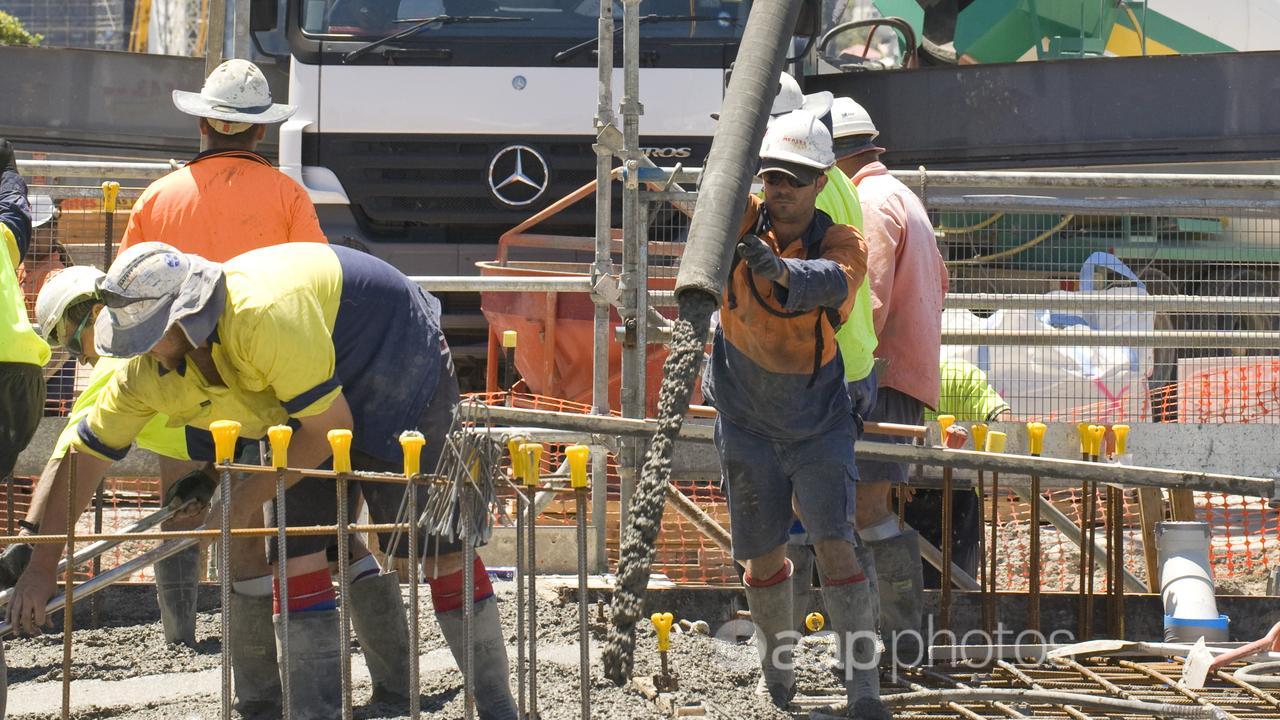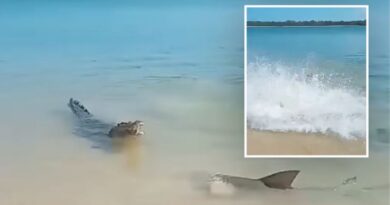Geologist wrong to claim wind turbines need 30,000 tonnes of concrete, iron ore
George Driver
December 13, 2024
WHAT WAS CLAIMED
It takes 30,000 tonnes of concrete and 30,000 tonnes of iron ore to build wind turbines
OUR VERDICT
False. Experts and industry representatives say these figures are wrong by a factor of 10 or more.

AAP FACTCHECK – A well-known climate change sceptic is falsely claiming wind turbines each require 30,000 tonnes of iron ore and 30,000 tonnes of concrete.
The claim was made in a Facebook video featuring University of Melbourne geology expert Ian Plimer.
“Professor Ian Plimer explaining what it takes to make a wind turbine,” the post is captioned.
In the video, Prof Plimer claims building a wind turbine is resource-intensive and damaging to the environment.
“To start with a wind turbine you need about 30,000 tonnes of iron ore [and] about 30,000 tonnes of concrete,” he says.

He goes on to make a range of claims about the environmental impact of the materials used in a wind turbine.
Prof Plimer has made numerous claims about climate change in the past that have been debunked by AAP FactCheck, Science Feedback, USA Today and AFP Fact Check.
AAP FactCheck asked Prof Plimer for evidence to support his statement but received no response.
Experts and industry figures told AAP FactCheck this latest claim is also false.
Multiple sources show wind turbines currently require between 1500 and 2560 tonnes of concrete and 470 to 1309 tonnes of iron ore, depending on the size and output of the turbine.
Mark Diesendorf, a renewable energy researcher at the University of NSW, said Prof Plimer’s figures were “a gross exaggeration”.

Dr Diesendorf referred to a 2023 US Department of Energy report that showed a land-based wind turbine required 108.9 tonnes of steel, 8.8 tonnes of cast iron and 398.7 tonnes of concrete per megawatt (table 6, page 21).
According to multinational mining company BHP, a tonne of steel requires about 1.6 tonnes of iron ore to produce.
Using these figures, a 6.2-megawatt (MW) wind turbine – a size used at some Australian sites – would require approximately 1080 tonnes of iron ore, 55 tonnes of cast iron and 2472 tonnes of concrete.
David Wood, a wind energy and mechanical engineering expert at the University of Calgary, told AAP FactCheck the claim was false.
He referenced a 2019 paper that looked at the materials required for a 2MW wind turbine, which required about 1116 tonnes of concrete in its foundations, 33 tonnes of cast iron and 294 tonnes of steel – equivalent to about 470 tonnes of iron ore.
Andrew Blakers, an expert in renewable power engineering at Australian National University, told AAP FactCheck the claim is false “by a factor of about 30”.
Professor Blakers referred to a report by Vestas, one of the world’s largest wind turbine manufacturers.

The report reveals the company’s 7.2MW wind turbines had a total mass of 928 tonnes, including about 813 tonnes of “steel and iron materials” (p2), while its smallest 2MW wind turbine was 230 tonnes, with 194 tonnes of steel and iron (p8).
Prof Blakers said he presumed the tens of thousands of tonnes mentioned was for a whole wind farm rather than a single turbine.
A number of wind farm developers also corroborated that the claim was false.
Acciona Energy is one of the world’s largest renewable energy companies, with several wind farm projects built or being developed in Australia.
An Acciona spokesperson told AAP FactCheck the 4.5MW turbines at its Mortlake South Wind Farm in Victoria required about 1500 tonnes of concrete and 525 tonnes of steel, equating to 840 tonnes of iron ore using BHP’s formula above.

The spokesperson pointed AAP FactCheck to a 2022 Issues in Science and Technology article that said replacing a 100MW gas-fired turbine would require at least 20 wind turbines “collectively requiring some 30,000 tons of iron ore and 50,000 tons of concrete”, which may have been where Prof Plimer’s figures come from.
TagEnergy is building a 1333MW wind farm near Geelong, Victoria, which it describes as the largest in the southern hemisphere.
A spokesperson for the company referred AAP FactCheck to a life cycle assessment produced by Vestas that detailed the materials used in its 6.2MW turbines (table 6, p42-43).
This showed a turbine and its foundations required about 2454 tonnes of concrete, 95 tonnes of cast iron and 724 tonnes of steel – which equates to around 1159 tonnes of iron ore.
New Zealand Wind Energy Association chief executive Kevin Hart pointed to an article by renewable energy consultancy DNV that reports a 5MW wind turbine required 850 to 900 cubic yards of concrete in the foundations, which would weigh about 1540-1635 tonnes.
Other sources also show Prof Plimer’s figures are incorrect. A 2020 report published by the European Commission’s Joint Research Centre said wind turbines used up to 132 tonnes of steel and up to 413 tonnes of concrete per megawatt of capacity (p21).
For a 6.2MW wind turbine, this would equate to about 1309 tonnes of iron ore and about 2560 tonnes of concrete. (AAP)



